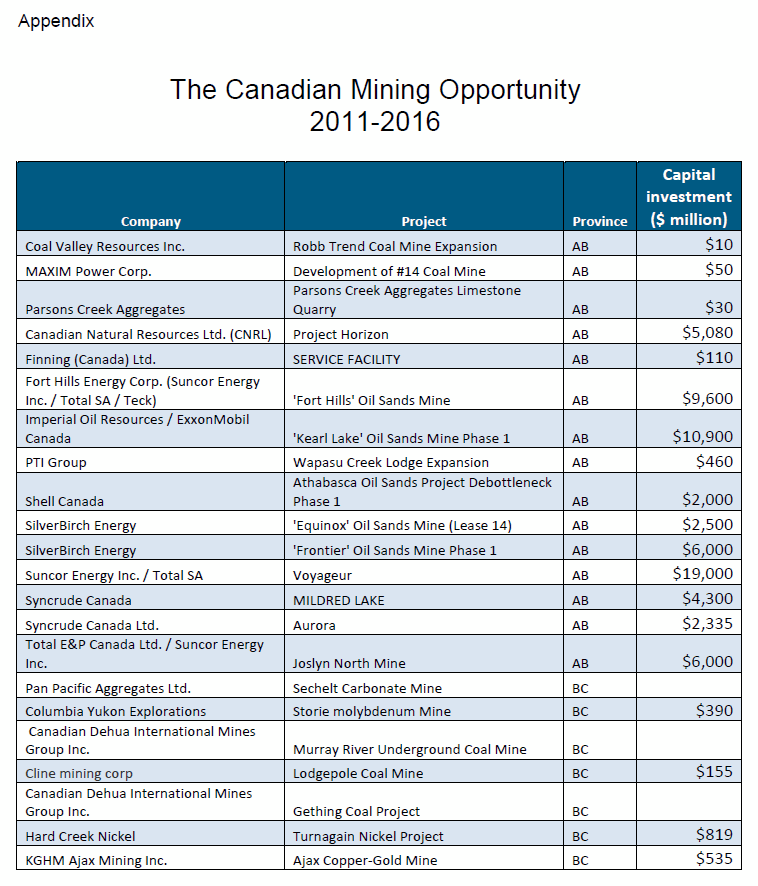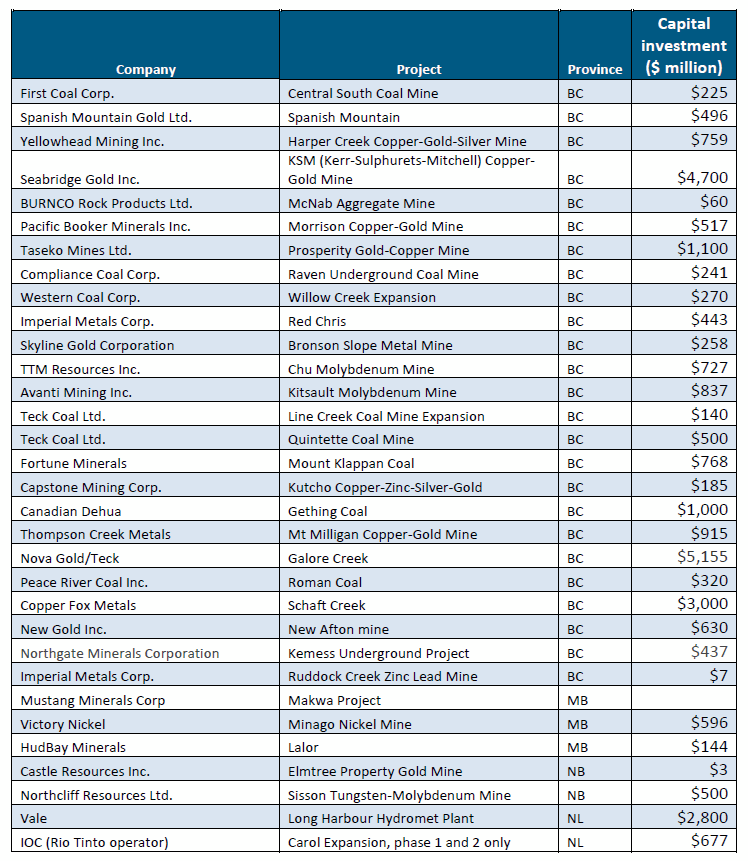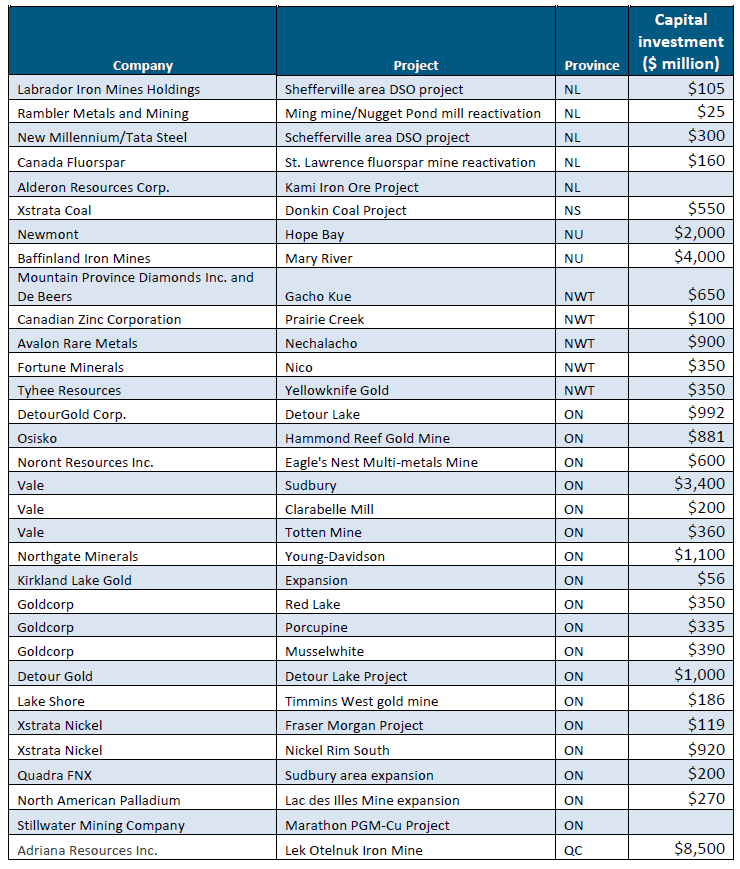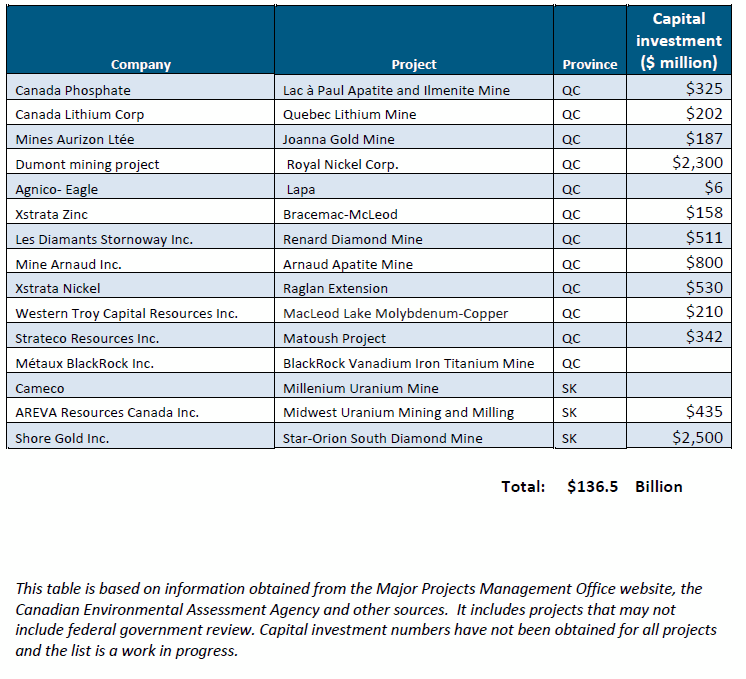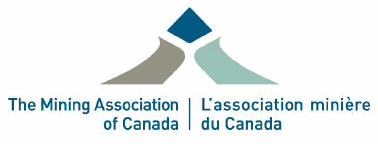
BRIEF FROM THE MINING ASSOCIATION OF CANADA
The intent of this brief letter is to describe the mining industry’s contribution to Canadian wealth, to outline the challenges that presently face the industry and to summarize the top five recommendations that would help governments and industry maintain these economic benefits for future generations.
Economic Contribution of the Industry
Canada’s mining industry is a major contributor to Canadian prosperity - contributing $35 billion to GDP in 2010 and, based on Natural Resources Canada definitions, employing 308,000 workers in mineral extraction, processing and manufacturing. While the industry is important in remote communities, it also generates prosperity in our major cities – Toronto, Vancouver, Montreal, Edmonton, Calgary and Saskatoon all feature areas of global mining leadership. As well, there are over 3,200 companies who provide inputs to the industry, ranging from engineering services to drilling equipment – this constitutes the world’s second largest mining supply sector.
The industry paid $8.4 billion in taxes and royalties to Canadian governments in 2010. The governments of Newfoundland and Labrador, Saskatchewan, Alberta, British Columbia, and the Northwest Territories all derive significant revenues from the mining industry. Post-recession, the industry’s trade levels have increased, with exports growing by 27% during 2010, to the point where mineral commodities presently account for 21% of total Canadian goods exports. A consequence of this global reach is that over half of the freight revenues of Canada’s railroads (CN and CP) are generated by the mining industry. Canada also features world-leading mineral exploration capabilities - with an estimated 1,000 Canadian exploration companies active in some 100 countries.
Present Economic Situation
After seven years of strong performance from 2000 to 2007, a global recession took hold in late-2008 and served to reduce Canadian GDP by 2.5% through 2009. Mineral prices fell in most commodities, operations in mines and smelters were reduced and mineral exploration spending curtailed. However, metal prices began to recover early in 2009 while global economic growth, again led by China, resumed in the final quarter of 2009 and has continued to be strong through 2010 and the first two quarters of 2011. Mineral prices have since increased significantly. In response, the utilization of Canadian mine capacity has grown from 50% in mid-2009 to 70% at end-2010, while use of smelting capacity grew from 72% to 80%. New mining projects have come into production, existing mines have undergone or are undergoing expansions while other new projects are again advancing through regulatory approvals. In examining growth projections in China, India and elsewhere, and assuming a positive and efficient Canadian investment environment, it is evident that strong economic prospects face the Canadian mining sector over the coming decades. Currently, MAC has estimated that new mining investment over the next five years alone could total over $130 billion, benefitting every region of the country (please see appendix: The Canadian Mining Opportunity).
Government has been Supportive
Governments have contributed positively to the competitiveness of Canada’s mining industry in recent years. For example, a five-year $100 million re-investment in geological mapping announced in 2008 will help address Canada’s mineral reserves challenge, particularly in northern Canada. On the tax front, reduction of the federal corporate tax rate to 15% by 2012 is positive, as are recent technical clarifications from the revenue agency. The Mineral Exploration Tax Credit associated with Canada’s flow-through share mechanism serves to enhance mineral exploration and discovery in Canada and to increase the depth of Canada’s global exploration expertise. In the regulatory area, changes through the implementation act of federal Budget 2010 have served to help minimize delays in initiating environmental assessments and to reduce barriers to better coordination between federal and provincial assessment. Regarding the rail freight service review, the government’s response has been constructive, containing useful measures relating to rail service agreements, non-performance penalties and metrics for ongoing measurement – these should be implemented.
Challenges Facing the Industry
Countering these positive moves, there remain many challenges facing the Canadian exploration and mining industry, including:
- Regulatory Processes - Federal regulatory processes continue to exhibit inefficiencies, inconsistencies and duplication and project review processes can take 5 years or longer to complete. The Auditor General’s office has itself stated that these delays and lengthy timelines do not contribute to improved environmental outcomes.
- Infrastructure – The mining industry is the largest customer for Canada’s transportation sector and requires good service, efficient logistics and competitive prices. This can sometimes be a challenge in the freight rail sector where a CN/CP duopoly exists. Investment is also needed in areas such as northern all-weather roads, sea ports, rail and inter-modal links and marine facilities such as Ridley Terminals (where the recent granting of borrowing authority is a positive development). Well-directed public investments can improve the economics of numerous potential mining projects in remote regions.
- Human Resources - The Canadian mining industry requires some 10,000 new workers per year over the coming decade to meet production targets – at a time when the skilled core of the industry is reaching retirement age, output of post-secondary programs is falling short of needs, and global competition for sought-after mining skills is increasing.
- Innovation - The mining industry invests an estimated $650 million annually in R&D, more than that of key sectors such as automotive and forest products, although there is a need to do more. Evolving technologies relate to 3-D data maps, systems to improve blasting, drilling and hoisting efficiency, tailings management and hydro-metallurgical processing, among other areas. The industry feels that government research mechanisms do not provide support commensurate with the industry’s needs, priorities and contributions.
Recommendations
To help address these and other challenges, MAC proposes the following recommendations to the finance committee for consideration in the lead-up to Budget 2012.
1) Address Regulatory Impediments and Inefficiencies – While not of obvious relevance to a finance committee, this issue is economic in nature – it directly affects the industry’s ability to bring jobs, wealth and growth to Canadians.
It is important that officials within the environment, fisheries and northern departments be mandated to work with industry and stakeholders to remove unnecessary regulatory, legislative and operational obstacles to sustainable economic development. In particular, the interpretation and application of the Fisheries Act should be clarified and made consistent, with a compliance system that is predictable and proportionate to risk. If necessary, regulatory or legislative amendments should be considered. The Canadian Environmental Assessment Act should be amended to recognize provincial processes that meet or exceed minimum federal requirements as equivalent to the federal process, and the delegation to provincial processes should be used more frequently in the meantime. Regulatory improvements should also be made to the Migratory Birds Convention Act and the Species at Risk Act, to provide industry with greater compliance certainty, reduce the potential for litigation and align better with provincial actions and requirements.
2) Make Strategic Investment in Infrastructure and Innovation - The ongoing extension of the Highway 37 transmission line in northeast BC, and the federal infusion of $130 million, is a good example of the positive impacts of infrastructure investment – this project will enhance the economics over time of an estimated $15 billion in mineral projects. Similarly, the planned extension of the Monts Otish highway in northern Quebec would improve future prospects for development of gold, diamond, copper and uranium projects in the surrounding region. In the far north, investment is needed in priorities such as all-weather roads and sea ports. Governments should work closely with industry to identify and invest in key transportation and energy infrastructure projects that help open regions to economic development and wealth creation.
Regarding the innovation challenge, the Canada Mining Innovation Council is in discussion with government agencies in the aim of enhancing support to the industry’s innovation priorities – these relate to tailings management, energy efficiency, effective exploration and other areas. One could argue that the strategic and important nature of Canada’s mining industry is not fully recognized by funding entities. Key federal entities such as the Natural Sciences Engineering Research Council should consider significantly enhancing their support of these priorities. Also, with respect to the federal SR&ED program, it is felt that the level of understanding of CRA officials regarding the mining sector, and its research priorities, would be improved through greater interaction between industry and government officials. A technical steering committee could also help improve consistency and timeliness of the claim and appeal processes.
3) Continue Addressing Skills Issues – Governments must work with industry, schools, Aboriginal groups and other communities to address the sector’s skills training, mobility and immigration needs. In this respect, the federal government’s support for the work of the Mining Industry Human Resources Council is valuable, as is support for the Construction Sector Council and the Petroleum Sector Council – all are supported through the federal government`s sector council program. We understand that core funding for the Sector Council program will be phased out over the next 18 months. MAC is cautiously optimistic that MiHR and its partners, including MAC, will find a way forward to maintain the council and support its good work. We urge the federal government to ensure that groups like MiHR are able to access future funding that supports labour market analysis and accreditation.
The Aboriginal Skills and Employment Partnership (ASEP) program has been highly successful since its creation in 2003, helping prepare over 18,000 Aboriginal Canadians for skilled jobs. Canada’s mining sector, the largest private employer of Aboriginal people, has been a very active partner and supporter of the ASEP program. We are concerned that ASEP is ending in 2012 – not just for the partnership contribution the federal government brings to Aboriginal training and skills development, but for the successful model that ASEP has brought to enhance the synergies between Aboriginal communities and the mining sector and to build trustful, working relationships. We are hopeful that other programs will be able to fill the gap that ASEP will leave.
Looking to the future, it is evident that Canada faces a period of significant and sustained potential. The industry’s ability to bring these projects into production in a sustainable manner depends on many variables, including the three that are highlighted in the above recommendations.
